Hypoxia
In some cases, vast stretches of open water become hypoxic, or low in oxygen. Unable to sustain life, these areas, called dead zones, may cause die-offs of fish, shellfish, corals, and aquatic plants.
Sources:
Additional resources:
Hood Canal Dissolved Oxygen Program
Independent review of human impacts on dissolved oxygen in Hood Canal
OVERVIEW
When are waters considered hypoxic?
The search goes on for a set of definitions and thresholds to represent low-oxygen concentrations that threaten various aquatic creatures. Over the years, ecologists have relocated, reshaped and revised the word “hypoxia” to describe these conditions. In part four of our series "Oxygen for life" we look at how scientists determine whether oxygen levels are low enough to be considered harmful to sea life.
RELATED ARTICLES
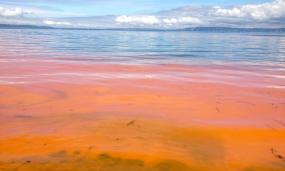
Understanding the causes of low oxygen in Puget Sound
How do excess nutrients trigger low oxygen conditions in Puget Sound and what do those conditions mean for the species that live here?

Puget Sound circulation triggers low-oxygen conditions at different times and in different places
The amount of oxygen in the Salish Sea is dependent on water circulation which distributes chemical elements such as nitrogen through the system.
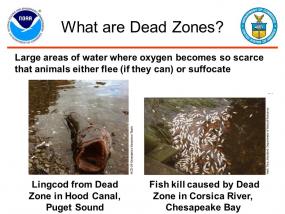
How the state assesses low oxygen in Puget Sound
Under the federal Clean Water Act, states are required to assess the quality of their surface waters and compile a list of polluted water bodies. The law mandates cleanup plans to address pollution and other water-quality problems. This article describes how this process works in Washington state for dissolved oxygen.
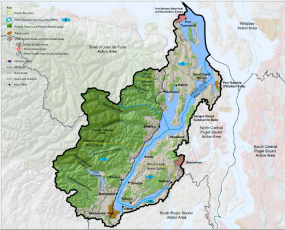
Review finds minimal evidence for human impacts on Hood Canal hypoxia
An independent review conducted by the Puget Sound Institute (PSI) is featured in findings by the Environmental Protection Agency and the Washington State Department of Ecology that there is currently “no compelling evidence” that humans are the cause for recent trends in declines in dissolved oxygen in Hood Canal.
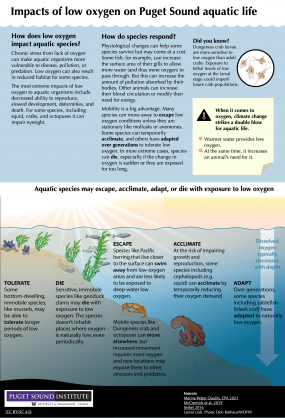
Impacts of low oxygen on Puget Sound aquatic life (infographic)
Chronic stress from lack of oxygen can make aquatic organisms more vulnerable to disease, pollution, or predation. Low oxygen can also result in reduced habitat for some species. Aquatic species may escape, acclimate, adapt, or die with exposure.
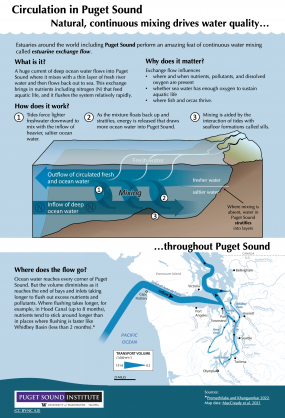
Circulation in Puget Sound (infographic)
Estuaries around the world including Puget Sound perform an amazing feat of continuous water mixing called estuarine exchange flow.
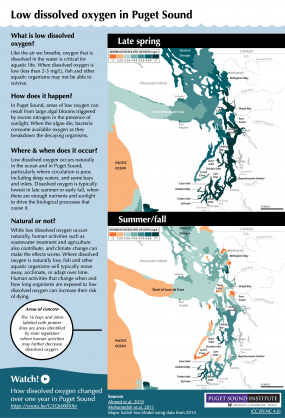
Low dissolved oxygen in Puget Sound (infographic)
Like the air we breathe, oxygen that is dissolved in the water is critical for aquatic life. When dissolved oxygen is low, fish and other aquatic organisms may not be able to survive.
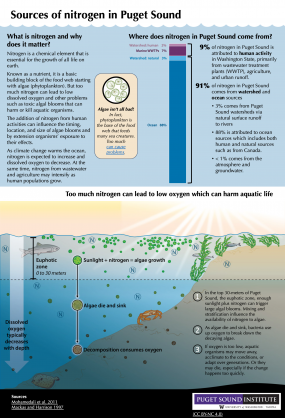
Sources of nitrogen in Puget Sound (infographic)
Nitrogen is a chemical element that is essential for the growth of all life on earth. But too much nitrogen can lead to low dissolved oxygen and other problems such as toxic algal blooms that can harm or kill aquatic organisms.

Hypoxia (fact sheet)
The following fact sheet provides an overview of low oxygen conditions in Puget Sound. It addresses some of the related causes and concerns that have been identified by scientists in the region. The overview was prepared in conjunction with a series of workshops on hypoxia and nutrient pollution presented by the University of Washington Puget Sound Institute.
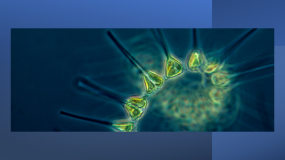
Phytoplankton and primary productivity (fact sheet)
In many parts of Puget Sound, hypoxic waters are thought to be at least in part due to overgrowth of microscopic algae, which is triggered by excess nitrogen. That means it’s important to understand the dynamics of primary productivity – the rate at which those microscopic algae, known as phytoplankton, produce organic matter through photosynthesis and in this way provide the base of the food web. Researchers are investigating different types of phytoplankton and rates of primary productivity throughout the Salish Sea, and seeking to understand how primary productivity is likely to change as climate change alters patterns of coastal upwelling and freshwater flow into the Sound.
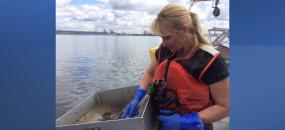
The role of sediment in nitrogen cycling and hypoxia (fact sheet)
How do marine sediments affect oxygen and nutrient levels in the water?
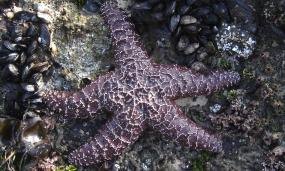
Oxygen for life: How low dissolved oxygen affects species in Puget Sound
Scientists are reporting a decline in oxygen-rich waters throughout the world. Causes for the decline vary from place to place but may involve climate change and increasing discharges of tainted water. In Puget Sound, low oxygen levels can occur naturally or due to eutrophication from human-caused pollution. In this five-part series, we describe the critical nature of oxygen to Puget Sound sea life. Scientists are finding that changes in oxygen levels can lead to physiological adjustments, shifts in predator-prey relationships and other repercussions throughout the food web.

How crabs respond to low oxygen in Hood Canal
As observed in Hood Canal, low-oxygen conditions can upend the lives of Dungeness crabs trying to stay alive. Levels of dissolved oxygen can alter predator-prey relationships for a multitude of species, affecting populations throughout the food web. Part two of our series "Oxygen for life" examines a crab case study.

Warmer waters will mean less oxygen for species
In time, lower dissolved oxygen worsened by climate change could increase the abundance of rare species in Puget Sound while putting populations of more common species into a tailspin. Part three of our series "Oxygen for life" looks at how warmer waters will gradually make it harder for many sea creatures to breathe.
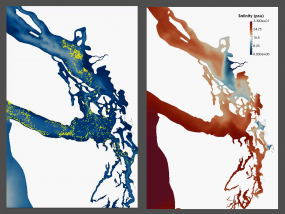
The Salish Sea Model
The Salish Sea Model is a computer model used to predict spatial and temporal patterns related to water circulation in the Salish Sea. It was developed at the United States Department of Energy's Pacific Northwest National Laboratory with funding from the Environmental Protection Agency. It is housed at the University of Washington Center for Urban Waters which is affiliated with the Encyclopedia of Puget Sound.
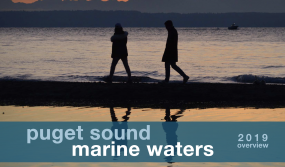
2019 Puget Sound Marine Waters Overview
A new report from the Puget Sound Ecosystem Monitoring Program details the effects of a changing climate on Puget Sound in 2019, and documents how these changes moved through the ecosystem to affect marine life and seafood consumers.
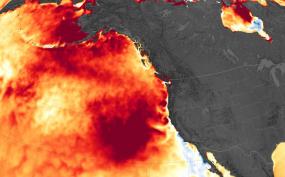
'The blob' revisited: Marine heat waves and the Salish Sea
Years after the appearance of the devastating marine heat wave known as "the blob," scientists are still working to understand how it has affected the Salish Sea. In some ways, they say, it is like the blob never left.
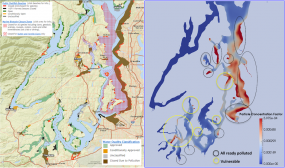
Ecosystem models expand our understanding of the Salish Sea
Scientists are using computer models to address complex issues in the Salish Sea like the rise of harmful algal blooms and the movement of toxic PCBs. LiveOcean, Atlantis and the Salish Sea Model are three systems that are changing the game for ecologists and other researchers.
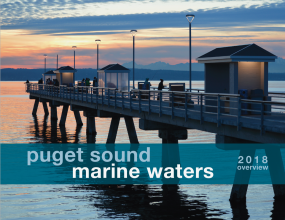
2018 Puget Sound Marine Waters Overview
A new report from the Puget Sound Ecosystem Monitoring Program says climate change altered the base of Puget Sound's food web in 2018, diminishing microscopic phytoplankton necessary for marine life. Scientists also observed lower abundances of fish, seabirds, and marine mammals.
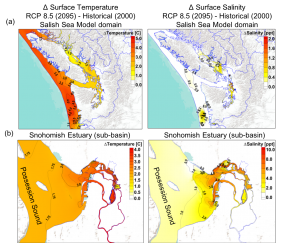
Salish Sea Model looks at climate impacts on the nearshore
A 2019 paper in the Journal of Geophysical Research: Oceans outlines how the Salish Sea Model describes the impacts of climate change, sea level rise and nutrient loads on the region's nearshore environment.
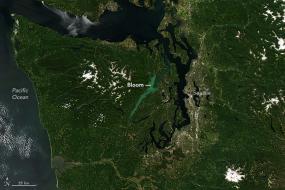
Does Puget Sound need a diet? Concerns grow over nutrients
As the region's population grows, scientists say we can expect to see increasing amounts of nitrogen and other elements flowing into Puget Sound. Known as “nutrients” these elements are naturally occurring and even necessary for life, but officials worry that nutrients from wastewater and other human sources are tipping the balance. That could mean big problems for fish and other marine life, gradually depleting the water of oxygen and altering the food web.
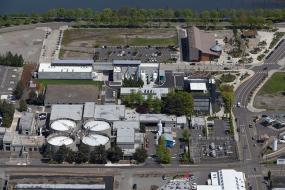
Sewage treatment plant in Olympia a leader in nitrogen removal
A regional sewage-treatment system in Thurston County has helped contain low-oxygen problems in Budd Inlet as the population continues to grow. The system cleans up some of the effluent for replenishing groundwater supplies.
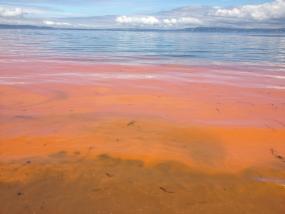
Dead plankton leave clues to a food-web mystery
High amounts of elements such as nitrogen can cause blooms of phytoplankton that sometimes trigger perturbations throughout the food web. This occurs most often in the spring and summer after the long, dark, cloudy days of winter begin to fade.

Puget Sound Ecosystem Monitoring Program
The Puget Sound Ecosystem Monitoring Program (PSEMP) is an independent program established by state and federal statute to monitor environmental conditions in Puget Sound.
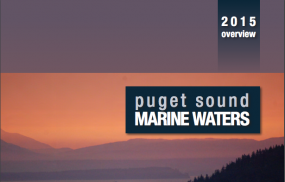
2015 Puget Sound Marine Waters Overview
The Puget Sound Ecosystem Monitoring Program released its fifth annual Marine Waters Overview this week. The report provides an assessment of marine conditions for the year 2015 and includes updates on water quality as well as status reports for select plankton, seabirds, fish and marine mammals.

Harmful algal blooms in Puget Sound
An algal bloom is a rapid increase or accumulation in the population of algae in a water system. While most are innocuous, there are a small number of algae species that produce harmful toxins to humans and animals.
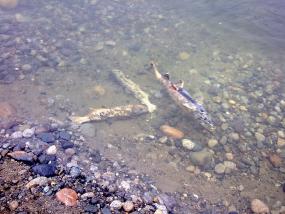
Transfer of nutrients in the ecosystem
Decaying organic matter plays an important role in marine ecosystems.
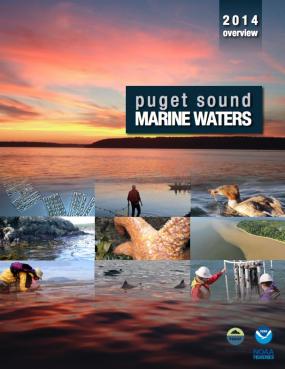
2014 Puget Sound Marine Waters Overview
A report from NOAA and the Puget Sound Ecosystem Monitoring Program provides an overview of 2014 marine water quality and conditions in Puget Sound from comprehensive monitoring and observing programs.
A study of the nutrients in the main basin of Puget Sound
This study compared recent and historical data to determine the presence of any significant changes in nutrient and oxygen concentrations subsequent to METRO discharge, examined seasonal cycles in water properties, and examined the flux of nutrients within the study area.
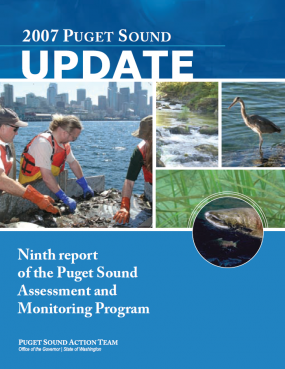
2007 Puget Sound Update
The Puget Sound Update is a technical report that integrates results of PSAMP and other scientific activities in Puget Sound focused on marine life and nearshore habitat, marine and freshwater quality, and toxic contamination.
Dissolved oxygen and hypoxia in Puget Sound
Hypoxia, defined as dissolved oxygen (DO) concentrations less than 2 mg / L, has become widespread throughout estuaries and semi-enclosed seas throughout the world (Diaz 2001).
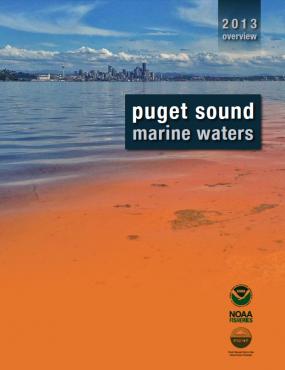
2013 Puget Sound Marine Waters Overview
A report from the Puget Sound Ecosystem Monitoring Program provides an overview of 2013 marine water quality and conditions in Puget Sound from comprehensive monitoring and observing programs.

The Puget Sound Model
The Puget Sound Model was designed and built in the early 1950s at the University of Washington School of Oceanography as a research and teaching tool for understanding Puget Sound circulation patterns.

2012 Puget Sound Marine Waters Overview
The Puget Sound Marine Waters 2012 Overview from the Puget Sound Ecosystem Monitoring Program synthesizes conditions measured in 2012 and has been expanded to include observations on seabirds that rely on marine waters. Read an excerpt below, or download the full report.
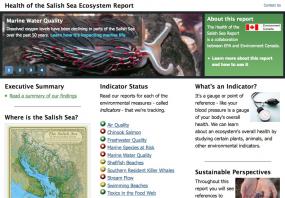
Report: 2013 Health of the Salish Sea Ecosystem Report
The 2013 Health of the Salish Sea Ecosystem Report was prepared jointly by the U.S. Environmental Protection Agency and Environment Canada. View the complete report, or read the Executive Summary below.
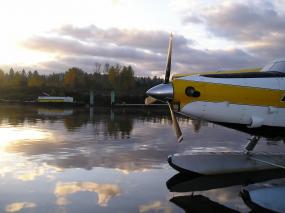
About the Eyes Over Puget Sound monitoring program
Once a month, Washington State Department of Ecology marine scientists take to the air to obtain high-resolution aerial photo observations and gather water data at the agency's monitoring stations and via state ferry transects. This provides a visual picture of the health of Puget Sound, which they call Eyes Over Puget Sound or EOPS.
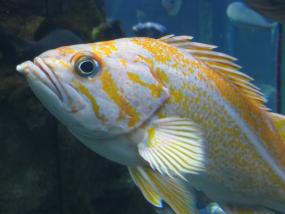
Report: Rockfish recovery in the Salish Sea
There are at least 28 species of rockfish in the Salish Sea, but their populations have declined in the past several decades. The proceedings from a 2011 rockfish recovery workshop in Seattle are now available.
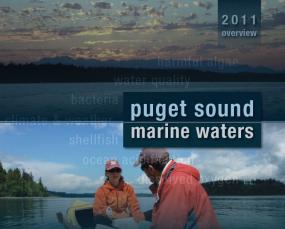
2011 Puget Sound Marine Waters Overview
The Puget Sound Marine Waters 2011 report is now available. The report was produced by the Puget Sound Ecosystem Monitoring Program and assesses the condition and quality of the waters of Puget Sound.

